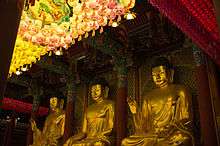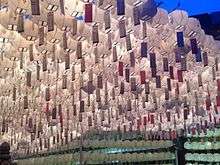Jogyesa
| Jogyesa | |
 | |
| Korean name | |
|---|---|
| Hangul | 조계사 |
| Hanja | 曹溪寺 |
| Revised Romanization | Jogyesa |
| McCune–Reischauer | Chogyesa |
Jogyesa is the chief temple of the Jogye Order of Korean Buddhism, becoming so in 1936.[1] It thus plays a leading role in the current state of Seon Buddhism in South Korea. The temple was first established in 1395, at the dawn of the Joseon Dynasty; the modern temple was founded in 1910 and initially called "Hwanggaksa." The name was changed to "Taegosa" during the period of Japanese rule, and then to the present name in 1954.
Jogyesa is located in Gyeonji-dong, Jongno-gu, in downtown Seoul. Natural monument No. 9, an ancient white pine tree, is located within the temple grounds.[2] Jogyesa Temple is located in one of the most popular cultural streets in Seoul, Insa-dong. Very close to the palace of Gyeongbokgung.
History


The Jogyesa Temple used to be known as Gakhwangsa Temple which was founded in 1395. During the Japanese colonial invasion the temple become one of the strongest fortresses of Korean Buddhism in 1910-1945. Gakhawangsa Temple emerged as the temple of the resistance to Japanese efforts to suppress Korean Buddhism. In 1937, a movement for the establishment of a Central Headquarters began which was successful with the building of the Main Buddha Hall of Jogyesa Temple in Seoul in 1938 [3]
The temple became known as Taegosa Temple in 1938 and by its current name of Jogyesa Temple in 1954.[3] The name Jogyesa Temple was chosen to denote the structure's status as the main temple of the Jogye Order of Korean Buddhism ( Buddhist sect which combines and integrates the Korean Zen and Textual Schools of Buddhism.)[3] Korean Jogye Order has 1700 years of history and is the Korean Buddhism Order most representative.[4] Surkgahmohnee doctrine and teachings of the Buddha Jogye order is based and focuses on the mind and the nature of this.[4]
The Daeoongjeong (Main Buddha Hall) was constructed in 1938 of pine wood from Baekdusan Mountain in North Korea, and it’s always filled with the sounds of chanting.[5] In the main temple courtyard there are two trees which are 500 years old, a White Pine and a Chinese Scholar tree. The White Pine tree is about 10 meters high and gave the nearby area “Su-Song Dong” its name (Song means pine tree in Korean).[5] This tree was brought by Chinese missionaries during the Joseon Dynasty.
This pine tree sits besides the main hall of the Jogyesa Temple, and its branch towards the main hall is only partially alive. One side of this tree is adjacent to the passage, while the other side sits next to the building.[6] Therefore, because the area is inadequate for the tree to grow, the Lacebark pine is not preserved well and since the Lacebark pine is a rare tree species and is valuable in biology, it is designated and protected as a Natural Monument.[6]
The Chinese Scholar tree, which is 26 meters tall and four meters in circumference, silently stands watch over the temple grounds.
Access
To enter the temple Jogyesa have to go through first Iljum or the one pillar gate. The Iljumun is an entry that represents is the division that separates the mortal world the world of Buddha.
Layout
Jogyesa Temple's features is a mix of traditional temple and palace architecture. The lattice designs found on the doors and windows of the Daeungjeon are unique in their own right.[7] The temple also features the Geuknakjeon (Hll of Supreme Bliss) in which the Amitabha Buddha is enshrined, the Beomjongnu, a structure where a bell which enlightens the public with its sound is housed, and an information cener for foreign nationals.[7]
Events
- Buddha's Birthday
The festival, designated Korea's Important Intangible Cultural Property No. 122, will take place at Jogyesa and Bongeunsa temples and along Jongno Street on May 6–8. The origin of the three-day festival dates back to the Unified Silla era over 1,300 years ago, when the festival was held on Daeboreum, a day celebrating the first full moon of the lunar calendar; During the Goryeo Dynasty (918-1392), Yeondeunghoe turned into a festival marking Buddha’s birthday.[8]
Lanterns featuring lotus and other traditional figures and objects representing people’s wishes will be hung on May 6–22, from 6 p.m. to midnight at Jogyesa Temple[8] The highlight of the three-day-long celebration is the Lotus Lantern Parade, which winds along Jongno Street from Dongdaemun Gate to Jogyesa Temple. With thousands of participants, each carrying their own lantern, the parade becomes a river of light flowing through the heart of Seoul.[9]
- Jogye Order
Jogyesa came to the attention of the international news media in December 1998 due to several monks occupying the temple in a power struggle between factions of the Jogye Order. In the end, riot police were called in to take control of the temple and oust the protestors after they had occupied the building for more than 40 days.[10][11]
- Kyeongsin Persecution
From 27 to 31 October 1980, during the Kyeongsin Persecution, the government raided major Buddhist temples throughout the country, including the headquarters at Seoul's Jogyesa, under the guise of anti-government investigations and an attempt to "purify" Buddhism.[12][13]
| Wikimedia Commons has media related to Jogyesa. |
Temple Stay
Temple stay is a cultural program which anyone can experience the life of buddha practitioners and also learn about the cultural knowledge transmitted throughout Korean Buddhist history. The temple stay of Jogyesa consists of various activities related to Korean tradition and buddhism. Everyone who wants to make distinctive and valuable memories such as experiencing Buddhism or talking with Buddhist practitioners can take part in.[14] And also this program show people how to control their mind and introspect themselves. People can make those techniques their second nature and can achieve inner peace by practicing them. It is a chance to know how to be happy.[14]
See also
- List of Buddhist temples in Seoul
- Buddhist temples in South Korea
- Religion in South Korea
- Religion in Korea
References
- ↑ "buddhapia.com". Retrieved 2010-06-04.
- ↑ http://jikimi.cha.go.kr/english/search_plaza_new/ECulresult_Db_View.jsp?VdkVgwKey=16,00090000,11
- 1 2 3 Yoo, Myeong-jong (2009). Temples of Korea. Myeong-jong. p. 148.
- 1 2 Official, Web Site. "Historic Cultural Memorial Center of Korea Buddhism and Jogye Order". Jogyesa Order of Korea Buddhism. jogyesa. Retrieved 22 May 2016.
- 1 2 "Templestay". eng.templestay.com. Retrieved 2016-06-19.
- 1 2 "::: Cultural Heritage, the source for Koreans' Strength and Dream :::". jikimi.cha.go.kr. Retrieved 2016-06-19.
- 1 2 Yoo, Myeong-jong (2009). Temples of Korea. Myeong-jong. p. 149.
- 1 2 Jung, Eun-jin (2016-04-26). "Lights celebrate Buddha's birthday". The Korea Herald (English Edition). Retrieved 13 May 2016.
- ↑ "Planet Depos CEO Lisa DiMonte Visits Korea for 2016 Seoul Lotus Lantern Festival | JD Supra". JD Supra. Retrieved 2016-06-19.
- ↑ "Dissident monks in Seoul evicted in police raid". Archived from the original on February 25, 2005.
- ↑ "Monks charged over temple violence". Hartford-hwp.com. Retrieved 2011-09-19.
- ↑ Harris, Ian (2001). Buddhism and politics in twentieth-century Asia. Continuum International Publishing Group. ISBN 978-0-8264-5178-1.
- ↑ Park, Jin Y. (1 February 2010). Makers of modern Korean Buddhism. SUNY Press. ISBN 978-1-4384-2921-2.
- 1 2 index. "조계사 영문". www.jogyesa.kr. Retrieved 2016-06-21.
External links
- Official site
- Jogyesa : Official Seoul City Tourism
- Brief illustrated profile
- KNTO Destination guide: Jogyesa
Coordinates: 37°34′26.09″N 126°58′54.85″E / 37.5739139°N 126.9819028°E
.jpg)
